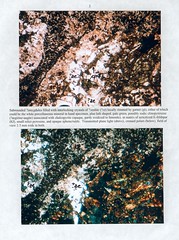FELSIC (ALKALIC) VOLCANIC OR HIGH-LEVEL INTRUSIVE WITH AMYGDULES(?) OF ?ZEOLITE/NEPHELINE?, GARNET, SODIC CLINOPYROXENE IN MATRIX OF SERICITIZED KSPAR-GARNET-CLINOPYROXENE-SPHENE/RUTILE-EPIDOTE
One sample submitted for petrographic description and identification of a mineral circled by black marker (unfortunately, this marking was cut off during section preparation, so not visible to the petrographer). The hand specimen is grey-buff in colour, fine-grained, with an altered porphyritic or amygdular volcanic texture; the amygdules are filled with a mixture of minerals that are partly oxidized to orange-brown limonite. The rock is not magnetic, and shows no reaction to cold dilute HCl, but the matrix largely stains bright yellow for K-feldspar in the etched offcut. Modal mineralogy in polished thin section is approximately:
K-feldspar (primary?) 45%
Garnet 20%
Clinopyroxene (aegirine-augite?) 15%
Unidentified (zeolite? or nepheline?) 10%
Sericite (after feldspar) 5%
Chlorite 2-3%
Sphene/rutile 1-2%
Epidote <1%
Apatite <1%
Chalcopyrite (partly replaced by limonite) <1%
Limonite <1%
This sample consists mainly of about 15-20% amygdules (or possibly relict mafic phenocrysts) filled with or replaced by a colourless mineral containing abundant poikilitic inclusions of clinopyroxene and locally garnet plus rare apatite, in a matrix composed mainly of K-feldspar partly to largely replaced by fine-grained sericite, plus garnet, clinopyroxene(?) and minor sphene/rutile and epidote.
The amygdules have subrounded to subangular outlines up to 2-9 mm long and are primarily filled with coarse subhedral crystals of a colourless mineral up to 3 mm in diameter, with the following optical properties: low (first-order grey to white) birefringence, moderate negative relief compared to epoxy (n<1.55), possibly biaxial negative (no well oriented sections available for interference figures). Its identity is not clear, but it could be a zeolite or nepheline(?), although lack of parallel extinction argues against the latter. The included pyroxene, forming small sub- to euhedral crystals mostly <0.35 mm long, has pale green pleochroism and moderate extinction angle up to about 35 degrees, suggesting it may be a sodic clinopyroxene such as aegirine-augite (?). The pyroxene is locally partly altered to a very fine-grained mixture of ?sericite and ?chlorite or "hydrobiotite (Fe-rich chlorite). In places, the amygdules are rimmed by, or locally almost completely composed of, garnet. The garnet forms mainly euhedral to subhedral, pale yellow-brown crystals up to about 0.7 mm in diameter, in masses up to as much as 3.5 mm across. The garnet is locally unusually anisotropic, showing zoning parallel to the crystal margins. Locally, apatite forms stubby euhedral prisms up to 0.15 mm long, or part of the amygdule is filled with chlorite (sheafs of small subhedral flakes mostly <0.1 mm in diameter), or relics of strongly sericitized K-feldspar forming laths mostly <0.5 mm long).
The matrix is composed of relict laths of K-feldspar, mostly with euhedral outlines <0.5 mm long, with interstitial garnet (locally as aggregates or skeletal crystals, sieved by inclusions, up to 1 mm across), plus abundant fine semi-opaque crystals of sphene mostly <25 microns in diameter with minute (micron-sized) inclusions of rutile, and minor epidote (subhedra to 0.1 mm). There also appears to be relict pale green clinopyroxene as ragged subhedra <0.1 mm long (mainly replaced by fine-grained sericite and chlorite).The K-feldspar is commonly partly to locally completely replaced by fine-grained sericite; the garnet is the same as described above for the amygdules.
Traces of chalcopyrite, forming subhedral crystals mostly <0.25 mm in diameter, are found in both the amygdules, associated with the pyroxene, and (to a lesser degree) the matrix. The chalcopyrite is generally rimmed by or partly to completely replaced by limonite.
In summary, this appears to be a strongly altered, volcanic or high-level intrusive rock probably of alkalic composition to judge by the abundant, possibly primary, K-feldspar and possibly sodic clinopyroxene. It is likely that the grey to white, porcellaneous mineral you circled is either the garnet, or possibly the ?zeolite/?nepheline, both of which (with the clinopyroxene) fill the amygdules. Trace sulfides appear to be mainly chalcopyrite, partly oxidized to limonite.
